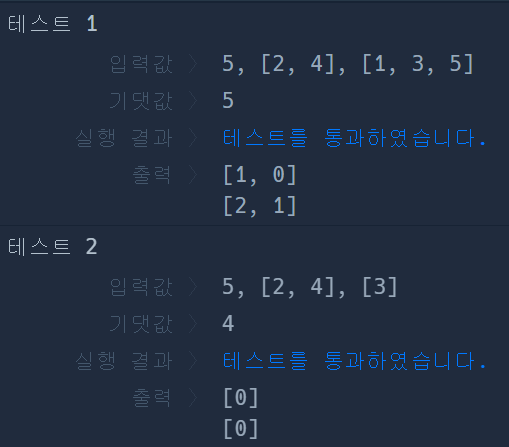
[Greedy][programmers]탐욕법 lv1 체육복
Tieck
·2021. 9. 8. 19:25
1. 문제
학생들의 번호 : 체격 순서 (바로 앞 또는 바로 뒤의 학생에게만 체육복을 빌려줄 수 있다.)
2. 이해
입력
- 전체 학생의 수 : n
- 체육복 X 학생들의 번호가 담긴 배열 : lost
- 여벌 체육복 O 학생 번호가 담긴 배열 : reserve
출력
return 체육 수업을 들을 수 있는 학생의 최댓값
조건
- 1 < n < 31 (n은 자연수)
- 1<= 체육복X 학생의 수 <= n, 중복 번호X
- 여벌 체육복O인 학생만 다른 학생에게 체육복을 빌려줄 수 있음
- 여벌 체육복O인 학생도 도난당할 수 있음. 무조건 1개만 도난당함 + 체육복 1개 남음(대여 불가상태로 변환)
- lost와 reserve에 중복 소속 가능 (1순위 체크)
예시
| n | lost | reserve | return |
| 5 | [2, 4] | [1, 3, 5] | 5 |
| 5 | [2, 4] | [3] | 4 |
| 3 | [3] | [1] | 2 |
3. 접근
#그리디 알고리즘 -> 전수 조사
1. lost와 reserve에 중복 소속된 번호 조사 -> 중복O이면 lost, reserve에서 제거 및 lost, reserve를 갱신
2. reserve의 모든 번호를 +-1 하여 can_rend list 만들기 (for문)
3. best can_rend list 찾기
4. answer = n - # of lost
4. 구현
try 1: 65점, fail
의도 : 선택된 번호가 가장 많은 알고리즘
구현 :
- lost 리스트의 모든 번호에 대해서 선택되지 않는 번호 중 앞번호 선택
- lost 리스트의 모든 번호에 대해서 선택되지 않는 번호 중 뒷번호 선택
- choice_list가 최대인 경우의 수 찾기
실제:
뒷번호, 앞번호에게 빌리는 경우를 각각 따로 계산해서 greedy하지 않음.
try1 :
채점 결과
정확성: 65.0
합계: 65.0 / 100.0
def solution(n, lost, reserve):
answer = 0
# 중복 번호 검사 -> 제거
for lnum in lost:
for rnum in reserve:
if lnum == rnum:
lost.remove(lnum)
reserve.remove(rnum)
# can_rend list의 모든 경우의 수
# len(lost)가 최소인 best_can_rend list 찾기
can_rend_list = []
before_list = []
after_list = []
for rnum in reserve:
if 1 == rnum:
before_rnum = rnum
else :
before_rnum = rnum - 1
if rnum == n:
after_rnum = rnum
else:
after_rnum = rnum + 1
# can_rend_list.append([before_rnum,after_rnum])
before_list.append(before_rnum)
after_list.append(after_rnum)
# afeter/before_list의 index = 체육복 빌려주는 주체
# afeter/before_list의 value = 체육복 빌리는 객체
# index는 중복 x
# index는 한번만 선택
# 이건 그리디 하지 않아!! 예외없이 경우의수 전수조사하는 알고리즘 짜기!
# 65점
max_choice = -9999
for lost_num in lost:
choice_list = []
if lost_num in before_list and lost_num not in choice_list:
choice_list.append(before_list.index(lost_num))
if lost_num in after_list and lost_num not in choice_list:
choice_list.append(after_list.index(lost_num))
if len(choice_list) > max_choice:
max_choice = len(choice_list)
answer = n - len(lost) + max_choice
return answer
- 빌릴 수 있는 경우의 수를 미리 계산하는 것은 불필요
- 중복을 제거하기 위해 이미 빌린
after_list, berfore_list 제거
try2 :
채점 결과
정확성: 85.0
합계: 85.0 / 100.0
def solution(n, lost, reserve):
answer = 0
# 중복 번호 검사 -> 제거
for lnum in lost:
for rnum in reserve:
if lnum == rnum:
lost.remove(lnum)
reserve.remove(rnum)
choice_list = []
# max_choice = -9999
for lost_num in lost:
print("lost_num : ",lost_num)
print(reserve)
print(choice_list)
if lost_num - 1 in reserve:
choice_list.append(lost_num)
reserve.remove(lost_num - 1)
print(lost_num,"이",lost_num-1,"에서 빌림")
elif lost_num + 1 in reserve:
choice_list.append(lost_num)
reserve.remove(lost_num + 1)
print(lost_num,"이",lost_num+1,"에서 빌림")
# print(choice_list)
answer = n -len(lost) + len(choice_list)
return answer
- 중복 검사 부분에서 반복문이 돌아가는 도중에 list가 변경되면 뭔가 문제가 생길 것 같다
- iterater 부분 공부 필요!
- 오답 : 테스트 7, 13, 14 번
try3 :
채점 결과
정확성: 90.0
합계: 90.0 / 100.0
def solution(n, lost, reserve):
answer = 0
# 중복 번호 검사 -> 제거
for lnum in lost[:]:
for rnum in reserve[:]:
if lnum == rnum:
lost.remove(lnum)
reserve.remove(rnum)
break
choice_list = []
for lost_num in lost:
print("lost_num : ",lost_num)
print(reserve)
print(choice_list)
if lost_num - 1 in reserve[:]:
choice_list.append(lost_num)
reserve.remove(lost_num - 1)
print(lost_num,"이",lost_num-1,"에서 빌림")
elif lost_num + 1 in reserve[:]:
choice_list.append(lost_num)
reserve.remove(lost_num + 1)
print(lost_num,"이",lost_num+1,"에서 빌림")
# print(choice_list)
answer = n -len(lost) + len(choice_list)
return answer
문자열 슬라이싱으로 배열 전체를 슬라이싱하여 복사했다.
테스트 7를 맞혔다.
- 오답 : 테스트 13, 14 번
try4: pass
채점 결과
정확성: 100.0
합계: 100.0 / 100.0
def solution(n, lost, reserve):
answer = 0
# 이전번호, 다음번호로 접근하기 위해선 정렬 필수
lost = sorted(lost)
reserve = sorted(reserve)
# 중복 번호 검사 -> 제거
# 반복문 안에서 반복하는 대상이 바뀌면 의도와 다르게 동작할 수 있음 -> copy, 리스트 슬라이싱으로 전체 복사 등
# O(N^2)? O(NlogN)?
for lnum in lost[:]:
for rnum in reserve[:]:
if lnum == rnum:
#remove는 공간복잡도 O(N)이라 안좋음. 다른 방식 찾아보기
lost.remove(lnum)
reserve.remove(rnum)
break
choice_list = []
for lost_num in lost:
print("lost_num : ",lost_num)
print(reserve)
print(choice_list)
#왼쪽에서 빌릴 수 있으면 빌리기
if lost_num - 1 in reserve[:]:
choice_list.append(lost_num)
reserve.remove(lost_num - 1)
print(lost_num,"이",lost_num-1,"에서 빌림")
# 빌릴수 없으면 오른쪽에서 빌리기
elif lost_num + 1 in reserve[:]:
choice_list.append(lost_num)
reserve.remove(lost_num + 1)
print(lost_num,"이",lost_num+1,"에서 빌림")
# print(choice_list)
answer = n -len(lost) + len(choice_list)
return answer
번호가 순서대로라는 조건이 없었다.
왼쪽 보고 없으면 오른쪽에서 빌린다는 조건이 성립하려면 순서대로 들어와야한다.
lost = sorted(lost)
reserve = sorted(reserve)
추가 후 통과
탐욕법이 성립하려면 빌릴 수 있으면 빌려야한다.
- lost와 reserve를 정렬하여 '순서대로' (이전 번호, 다음 번호 관계 성립의 전제 조건)
- lost와 reserve : 중복 제거
- 이전 번호에서 빌릴 수 있으면 빌리기
- 다음 번호에서 빌릴 수 없을 때, 오른쪽에서 빌릴 수 있으면 빌리기
팁
간단하게 도식화 할때
체육복의 개수를 사용하여 경우의 수를 고려하는 것이 유용
체육복 없음 : 0
체육복 1개 : 1
체육복 reserve : 2
예제 1의 n=5, lost = [2,4] , reserve = [1, 3, 5]의 경우
2 0 2 0 2 로 생각하면 다른 케이스를 생각할 때 좋다.
(번호 순서대로 1 2 3 4 5 이다.)
'알고리즘' 카테고리의 다른 글
| [문자열][programmers] 문자열 다루기 기본 (0) | 2021.10.05 |
|---|---|
| [로드맵] 코딩테스트 학습 개괄 (0) | 2021.10.04 |
| [Greedy]그리디 알고리즘 (0) | 2021.09.06 |
| 시간복잡도 / 공간복잡도 (0) | 2021.09.03 |
| [codeup]6096 : 바둑알 십자 뒤집기(py) (0) | 2021.09.02 |



